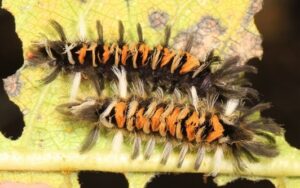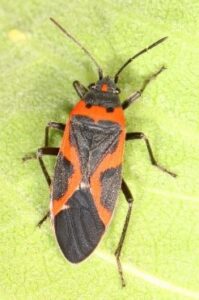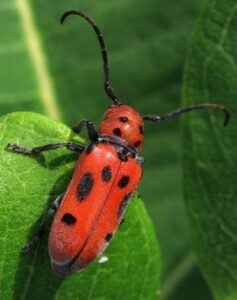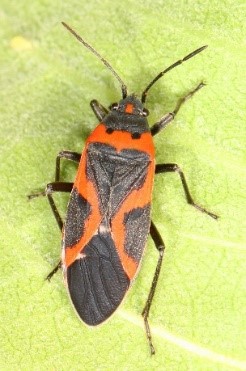By Uriah St. John, Seasonal Naturalist
When most people think about milkweeds and animals associated with them, one insect immediately comes to mind: the monarch butterfly. While in our minds this butterfly might be the “monarch” of the milkweeds, there are many other insects that are also specially adapted for milkweeds. So today let’s look at three other Ohio insects who also call milkweeds home; the milkweed tussock moth, milkweed bug, and the red milkweed beetle.

The milkweed tussock moth is a species of tiger moth which lay their eggs on milkweed. Whereas a monarch will lay singular or small bunches of eggs on leaves, the milkweed tussock moth can lay over 50 eggs on one plant. These large groups of caterpillars can quickly defoliate a milkweed after which they must either find a new plant or starve. After the caterpillar stage, the larva will pupate and weave a cocoon where they’ll spend the winter. Once they emerge in the spring the moths cannot eat, and their only goal is to mate. To achieve this goal the males have evolved the ability to make ultrasonic clicks to attract the females. These clicks are also a defense mechanism as bats know the clicks come from a poisonous moth and will not eat them.

The next insect on our list is the milkweed bug. Milkweed bugs are a member of the order of insects known as true bugs. They use their long mouthparts to inject digestive enzymes into milkweed pods. These enzymes liquify parts of the plant and the bug then sucks out the liquid for food. While the milkweed bug is native to Ohio, it is at the northern end of its range, and cannot survive our cold winters. Therefore, each year at the end of summer the milkweed bug migrates to the southern US, and slowly returns the next year as the weather warms.

The last one we’ll talk about, but certainly not the last insect that lives on milkweed, is the red milkweed beetle. The red milkweed beetle is a type of long-horned beetle, named for their long antenna. Like the other insects we’ve talked about they eat milkweed, but they have a special problem the others do not. The milky sap of the plant can glue their jaws shut if they’re not careful. To prevent this the red milkweed beetle will cut the veins of the leaf at its base. This drains the sap out of the leaf so the beetle can eat it safely. The beetle’s larvae are also unique among the ones we have looked at. The beetle does not lay its eggs on the leaves of the milkweed, but rather on the stem. Once the eggs hatch the larvae burrow into the stem and down to the roots where they spend the fall and winter. Once the weather warms the larvae pupate and then turn into their adult form. In their adult form, the beetles re-emerge and begin feeding on the fresh milkweed.
While we just looked at these three insects that call milkweed home there are also many others I didn’t mention. So next time you walk by some milkweed be sure to stop and take a look to see what amazing insects you can find!







